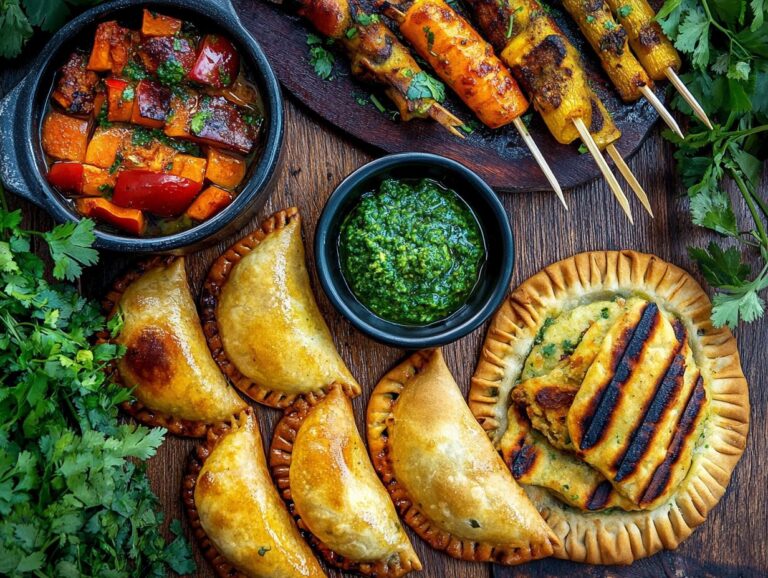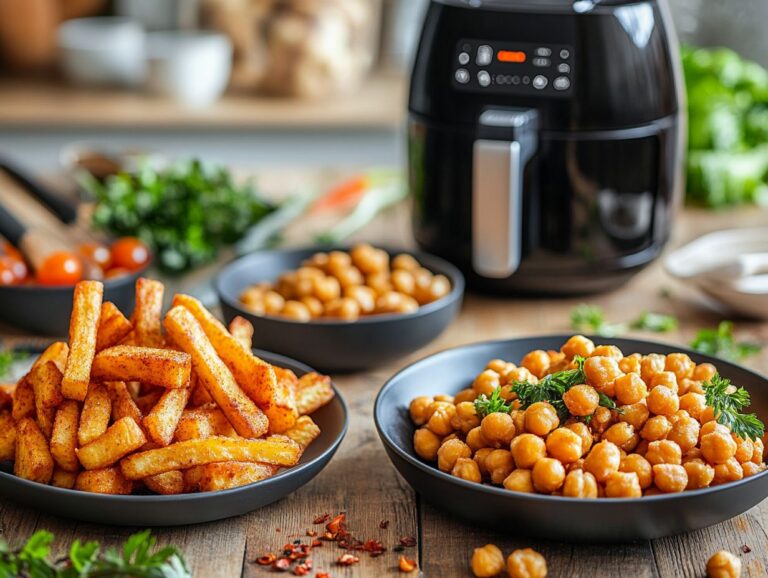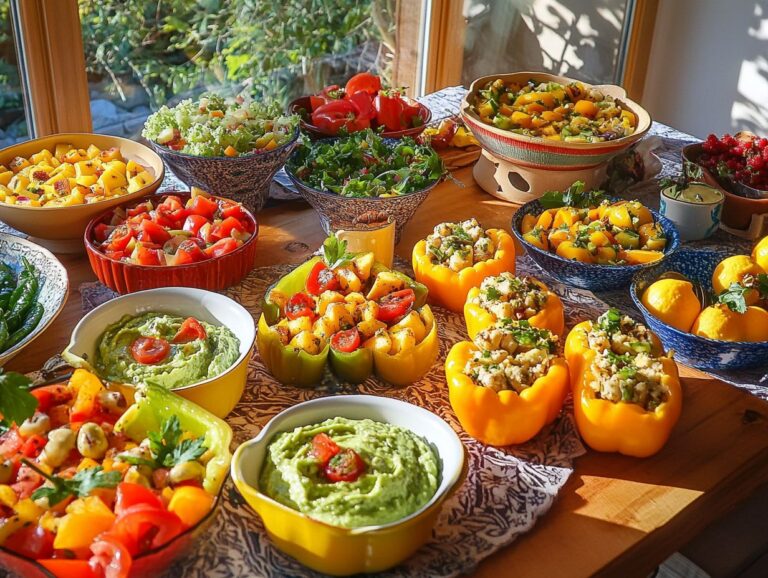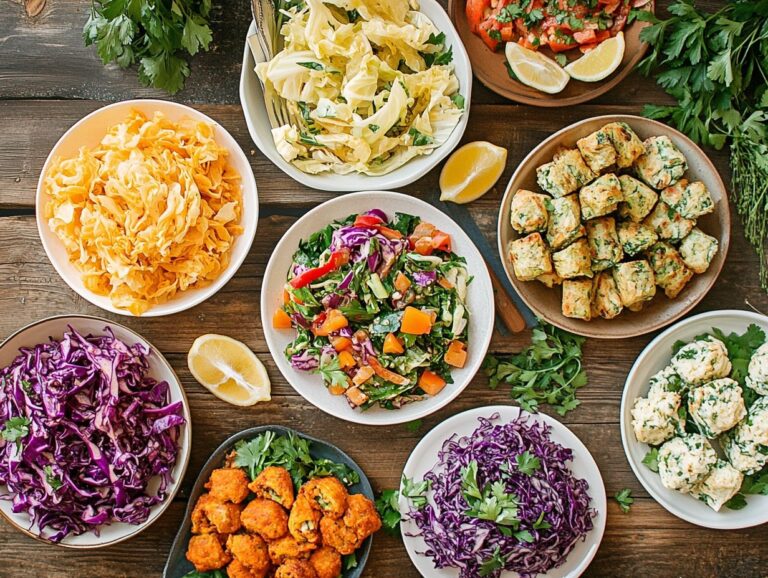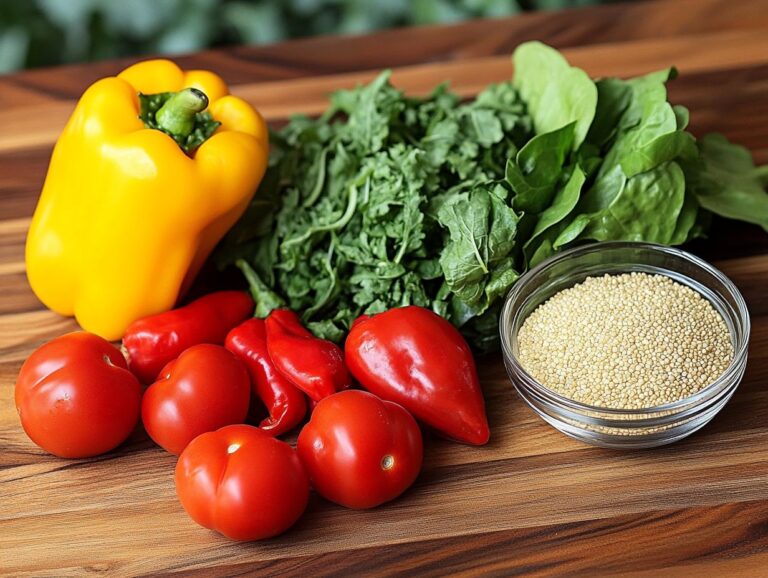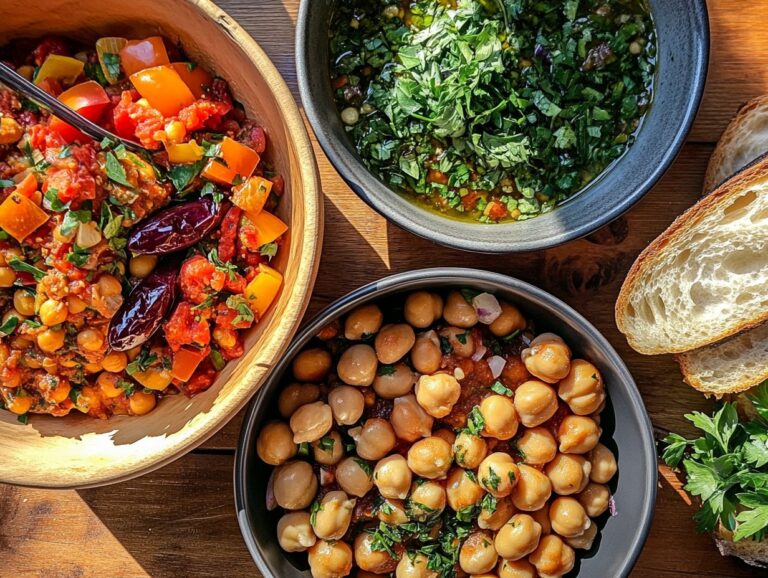Hawaiian cuisine is a vibrant tapestry of flavors, shaped by its diverse culture and the abundance of local ingredients. This culinary journey invites you to explore traditional Hawaiian staples and see how they can be transformed into delicious Hawaiian vegan recipes. From popular Hawaiian-inspired recipes that celebrate the unique produce of the islands to creative twists that infuse tropical flavors into classic vegan meals, you will learn how to create a memorable vegan Hawaiian feast. Prepare to savor the essence of the islands with delicious flavors and refreshing taste!
What Makes Hawaiian Cuisine Unique?
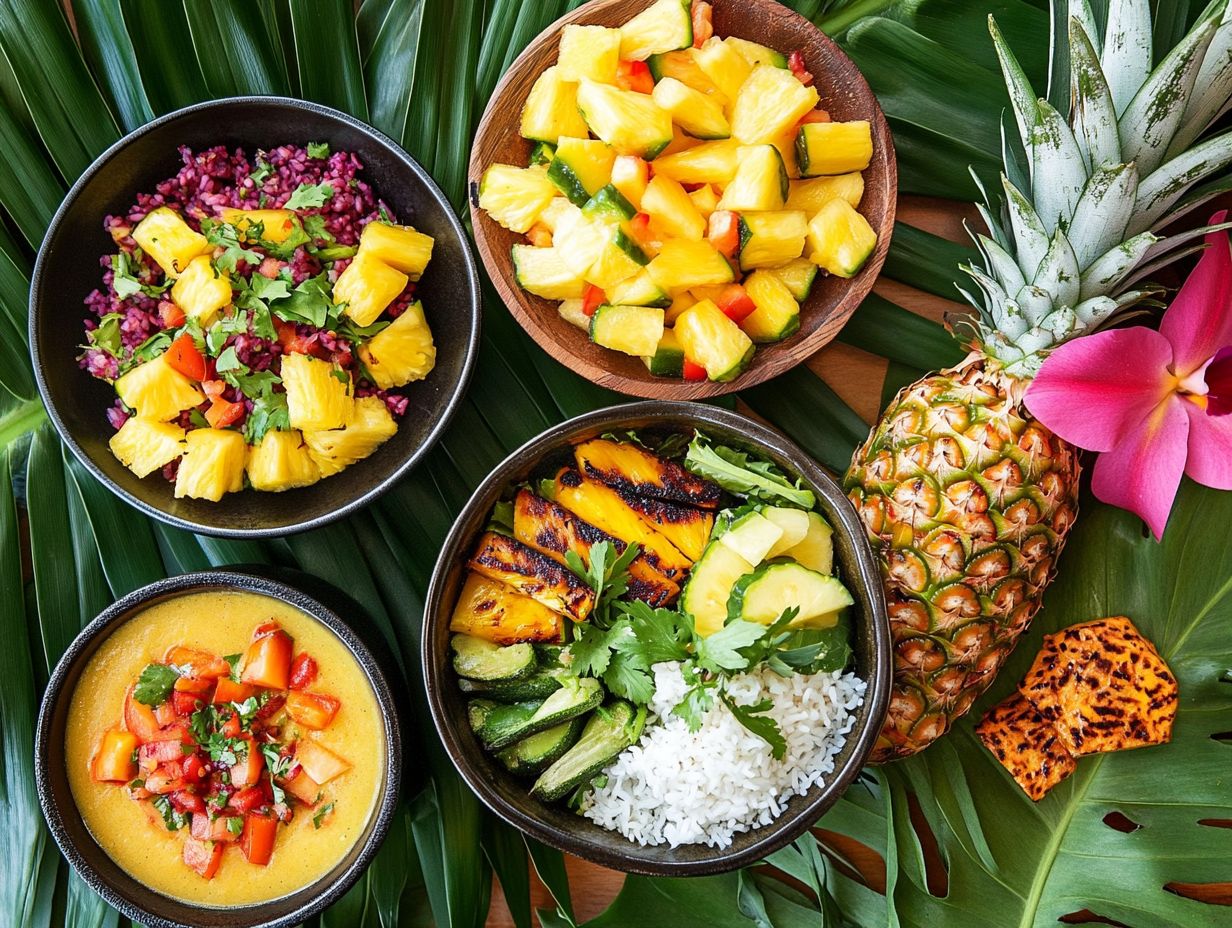
Hawaiian cuisine is a vibrant blend of Hawaiian food, tropical flavors, and influences that reflect the rich cultural heritage of the islands, setting it apart from other global culinary traditions.
This cuisine is distinguished by its use of fresh produce, tropical flavors, and a variety of cooking methods that produce an array of savory dishes and delightful tastes.
The emphasis on locally sourced produce and seafood underscores the connection between the land and the sea, resulting in a culinary journey as dynamic as Hawaii’s landscape itself.
This culinary journey encompasses everything from traditional Hawaiian food to modern interpretations and vegan kitchens.
Traditional Hawaiian Ingredients
Traditional Hawaiian ingredients play a vital role in the creation of authentic and flavorful Hawaiian dishes, reflecting the islands’ rich agricultural bounty. These ingredients are essential in crafting Hawaiian-inspired recipes and include:
- Hawaiian Fruits: Fresh fruits such as pineapple, banana, papaya, guava, passionfruit, coconut, and lychee are staples in Hawaiian cuisine.
- Hawaiian Vegetables: Vegetables like taro, sweet potatoes, cauliflower, and pumpkin form the foundation of the Hawaiian diet, adding a sweet flavor and savory element to dishes.
- Starchy Ingredients: Taro, known locally as kalo, is a staple in traditional Hawaiian cooking. It is primarily used to make poi, a thick paste that commonly accompanies many Hawaiian dishes. Other starchy ingredients, such as rice, corn, and sweet potatoes, also hold significant importance in traditional Hawaiian cuisine.
- Coconut: Coconut milk is a key ingredient in many Hawaiian recipes, creating coconut-infused dishes, while coconut water remains a popular refreshing drink in Hawaii.
- Jackfruit: This tropical fruit is often utilized as a meat substitute in Hawaiian cuisine due to its texture, which resembles pulled pork. Jackfruit can be flavored with traditional Hawaiian spices and sauces, making it ideal for Lūau jackfruit tacos.
These fresh ingredients are essential to the essence of Hawaiian food and adapt well in a vegan kitchen, enabling the creation of vegan recipes such as Hawaiian-style vegan fried rice and tropical salads, perfect for a plant-based lifestyle.
Exploring Local Produce and Staples
Local Produce and Staples
The characteristics of Hawaiian cuisine are heavily influenced by local produce and staples. The Hawaiian islands boast a rich variety of fruits and vegetables that enhance the flavor and texture of their dishes, contributing to vibrant dishes and nutritious meals. Chunks of local sweet pineapple, papaya, or mango serve as delightful side dishes or desserts, bringing a sweet flavor and refreshing taste. Traditional poi is made from staples like mashed taro, sweet potato, or banana. Fresh local fruits and vegetables are integral to both traditional and modern dishes, elevating the overall flavor and visual appeal, capturing the taste of Hawaii.
Among the most frequently used local ingredients in Hawaiian cuisine is the vibrant lilikoi, or passion fruit. This tart fruit is often incorporated into glazes for fresh fish, used as a topping for butter mochi (a popular Hawaiian dessert), or featured in lilikoi cake, adding a refreshing taste. Sweet potatoes, known as ‘uala,’ play a vital role in the preparation of poi, a starchy side dish commonly served with traditional Hawaiian meals such as luau. ‘Uala’ is a staple in Hawaiian cuisine and is often enjoyed in its mashed form.
Coconut is another essential component of traditional Hawaiian cooking. Coconut milk is frequently used in curries, while shredded coconut is a key ingredient in many traditional desserts. The coconut symbolizes Polynesian agriculture, and its role in Hawaiian cooking highlights the islands’ rich agricultural heritage, making coconut milk and coconut-infused dishes staples in vegan Hawaiian cuisine.
Popular Vegan Hawaiian Dishes
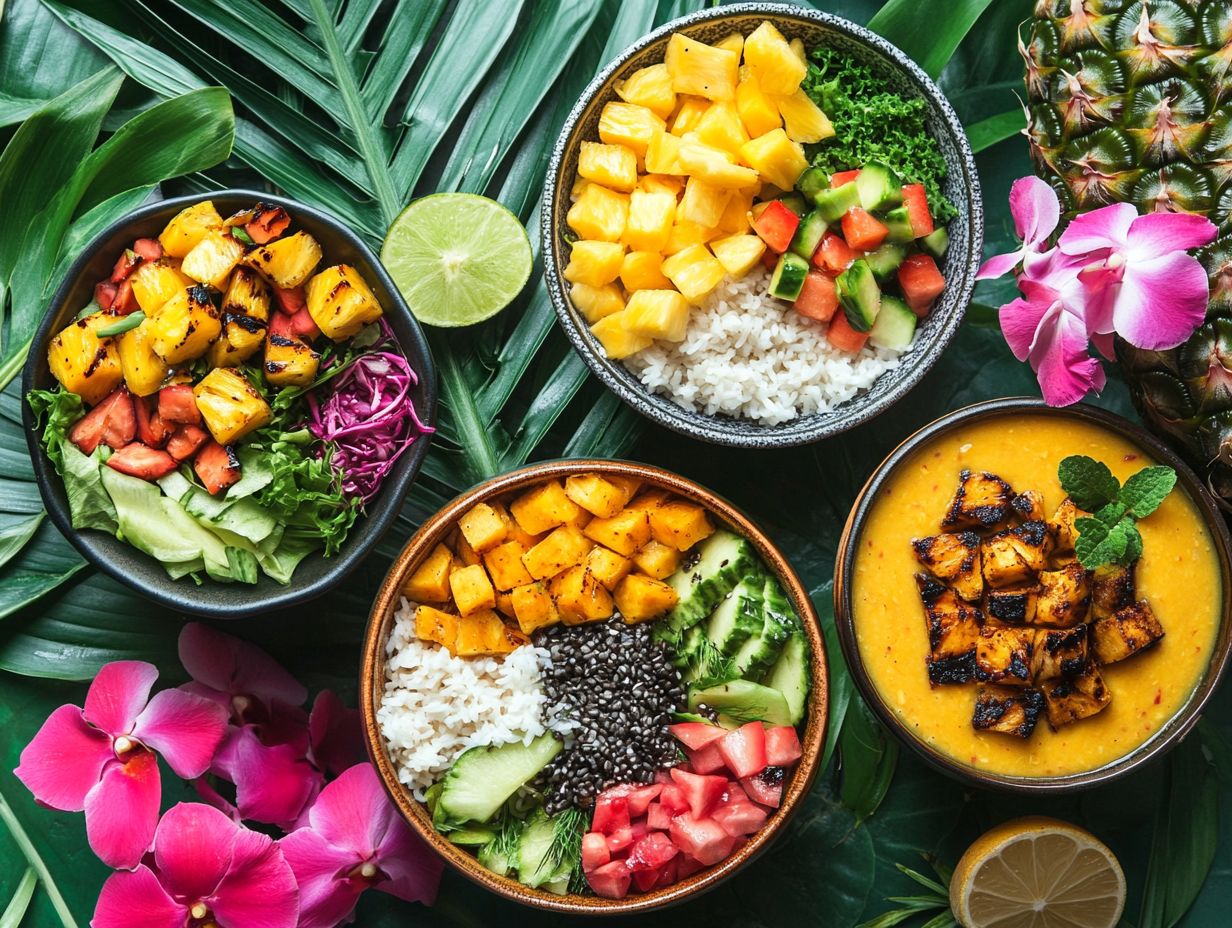
Popular vegan Hawaiian dishes, such as those listed below, demonstrate how traditional Hawaiian recipes can be adapted with plant-based ingredients while preserving the essence of island flavors and Asian flavors.
Some examples include:
- Tofu poke bowls with marinated tofu
- Lūau jackfruit tacos
- Lā’au stew with mushrooms
- Vegan pineapple fried rice
- Vegan Hawaiian sweet bread with coconut cream
These vegan Hawaiian dishes reflect the trend toward healthier eating and the increasing popularity of vegan cuisine. Not only do they provide a delightful way to experience the flavors of Hawaii, but they also offer nutritious options that support a plant-based lifestyle, making them perfect for summer gatherings or quick weeknight dinners.
Recipes for Classic Favorites
Vegan versions of traditional Hawaiian dishes retain familiar flavors while offering healthy alternatives for those who prefer plant-based meals. Dishes such as Hawaiian-style vegan fried rice and Hawaiian acai bowls utilize nutrient-dense ingredients and the region’s tropical flavors, making them easy to prepare and suitable for meal prep. These recipes showcase the best of Hawaiian cuisine, combining rich flavors with readily available fresh local ingredients to create hearty and nutritious options.
Hawaiian Fried Rice Recipe
This vegan Hawaiian-style fried rice uses bell peppers, shiitake mushrooms, and green onions to closely mimic the taste and texture of traditional fried rice while remaining fully plant-based.
Ingredients:
- 2 cups cooked rice (preferably day-old)
- 1 cup mixed frozen vegetables (peas, corn, carrots)
- 1 cup bell peppers (red, yellow, green)
- 1 cup shiitake mushrooms (or any mushroom variety)
- 3 green onions
- 1 tbsp soy sauce
- Salt and pepper to taste
Instructions:
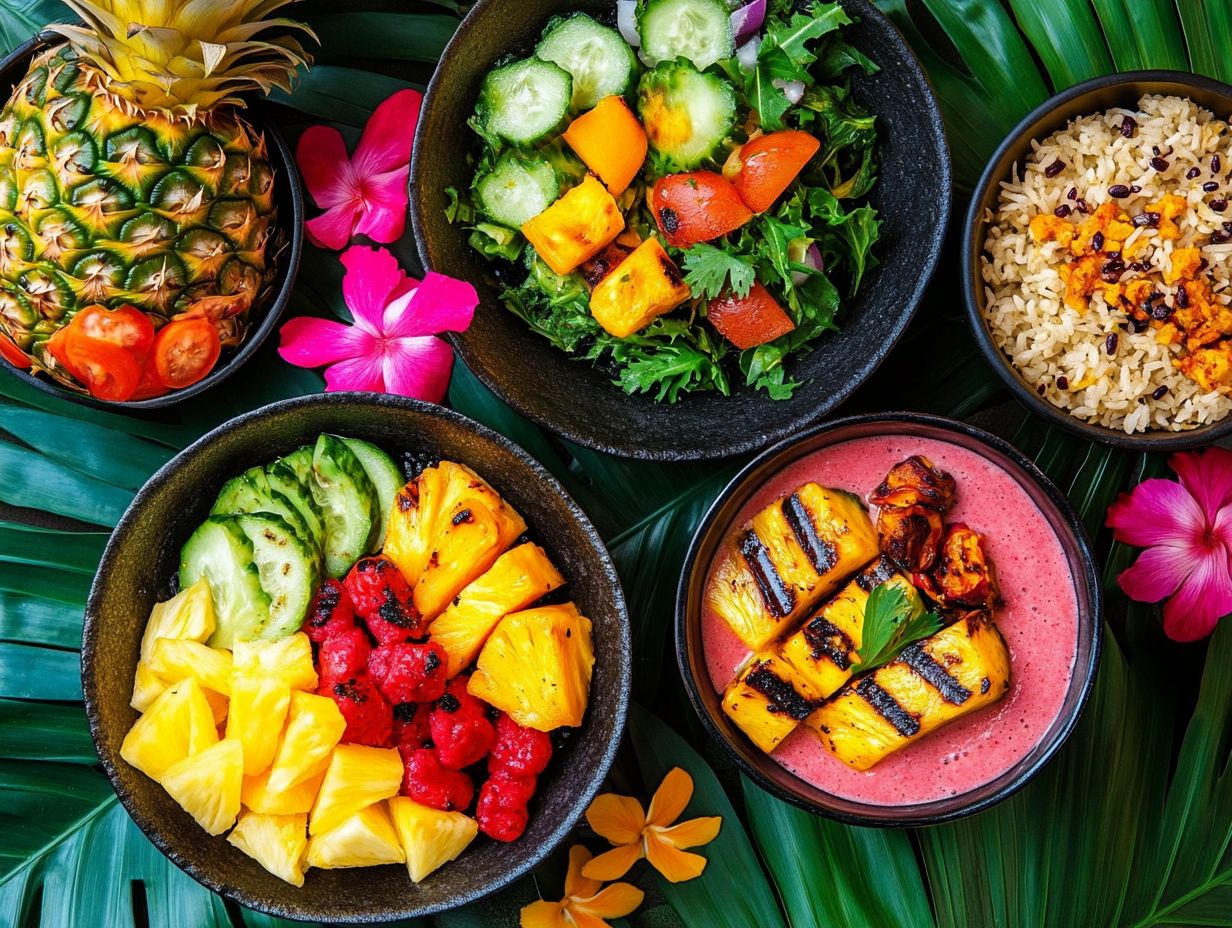
- Heat oil in a skillet.
- Add the bell peppers and mushrooms, cooking until softened.
- Stir in the frozen mixed vegetables and heat until warmed through.
- Add the cooked rice, soy sauce, salt, and pepper; mix well.
- Fold in the green onions, and serve with lime juice and chili sauce.
Hawaiian Acai Bowl Recipe
A delicious and refreshing tropical breakfast or afternoon snack can be achieved with a frozen acai puree blended with frozen bananas and other ingredients, then topped with fresh fruits, crunchy granola, and coconut flakes.
Ingredients:
- 2 packs frozen acai puree (unsweetened)
- 1 ripe banana
- ¼ cup coconut milk
- 1 tbsp honey (optional)
- ½ cup granola
- ¼ cup coconut flakes
- 2 tbsp chia seeds
- ½ cup diced mango
- ½ cup sliced strawberries
- ½ cup diced kiwi
- ½ cup blueberries
Instructions:
- Blend the banana, coconut milk, and honey (if using) until smooth.
- Add the acai packs and blend until thick and creamy.
- Pour the mixture into a bowl and top with granola, coconut, chia seeds, and diced fruits.
- Serve immediately.
Tropical Twists on Vegan Staples
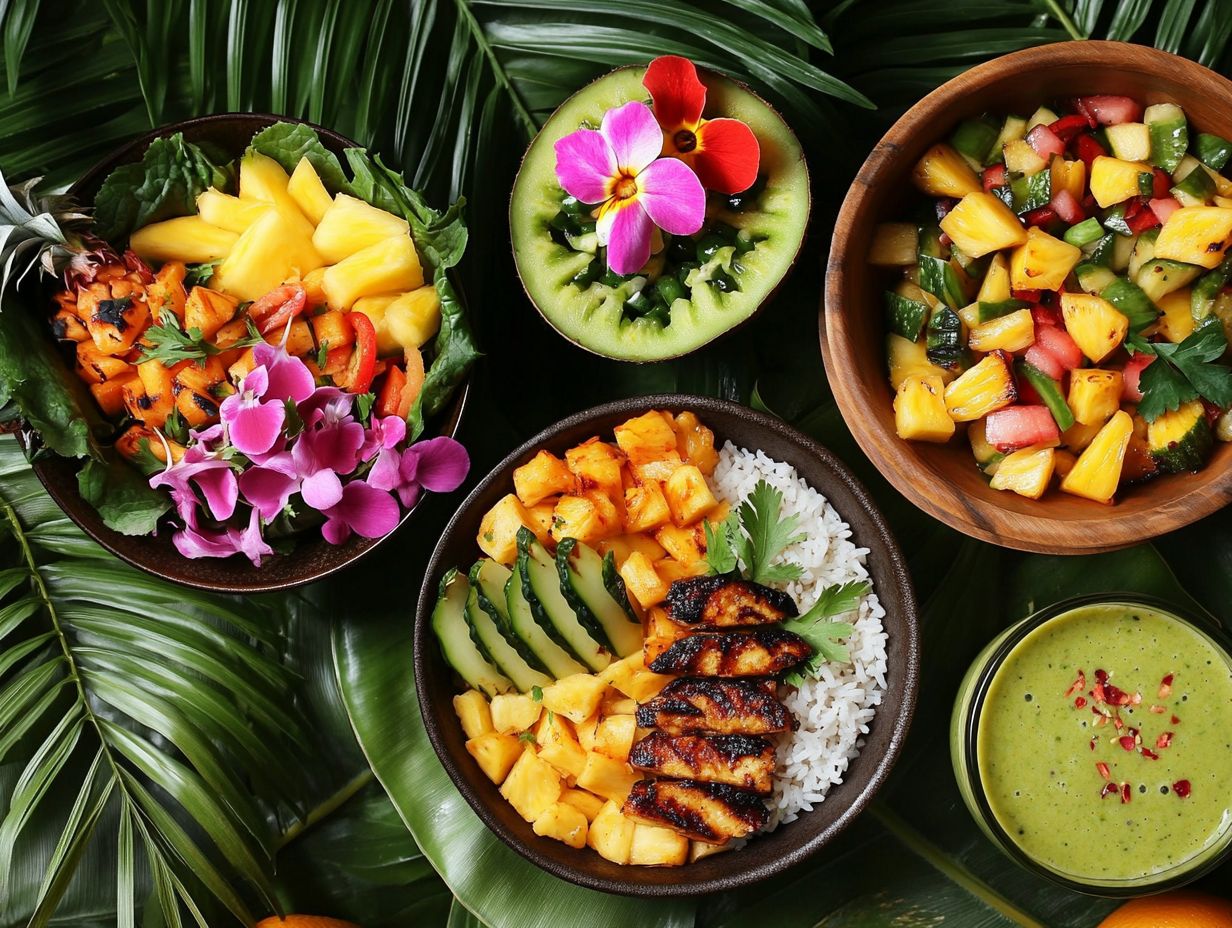
Tropical twists on vegan staples feature recipes that incorporate coconut milk, fresh herbs, and a variety of tropical fruits, enriching traditional vegan meals with the vibrant flavors of Hawaii.
These dishes encompass both salads and hearty entrées that are packed with protein.
Incorporating Island Flavors into Vegan Meals
Incorporating island flavors into vegan meals allows cooks to explore a fusion of tastes that elevate everyday dishes to new culinary heights. Ingredients like garlic tofu provide protein, crispy jalapeños add spice, and savory sauces contribute texture, ensuring that meals are flavorful and reflective of Hawaiian culinary traditions.
This enables vegan kitchens to create vibrant dishes that capture the essence of Hawaiian food for a diverse audience seeking nutritious options. To truly evoke the spirit of the islands, elements such as coconut milk can add creaminess, tangy pineapple can introduce sweetness, and umami-rich miso can deepen the flavor profile.
Techniques like marinating vegetables and proteins in citrus-infused dressings enhance the overall taste experience. Pairing dishes with a zesty cilantro-lime sauce adds a refreshing brightness.
By incorporating authentic Hawaiian flavors through a blend of fresh herbs and spices, cooks can create meals that reflect the tropical landscapes of the islands.
Creating a Vegan Hawaiian Feast
A vegan Hawaiian feast is a plant-based menu inspired by the diverse culinary heritage of the islands.
By selecting a variety of flavorful Hawaiian dishes—from light tropical salads to hearty Hawaiian-style vegan fried rice—hosts can craft a delightful representation of summer potlucks and festive gatherings.
This approach not only highlights the rich diversity of Hawaiian cuisine but also emphasizes the significance of meal preparation in creating a successful feast.
Menu Ideas and Tips for Hosting
The primary challenge in planning a vegan Hawaiian menu lies in achieving the right balance between variety and complexity. A diverse selection of flavors and textures, along with a considerable number of dishes, can make a meal feel special. However, an overwhelming amount of food or excessive complexity may be daunting for the host.
To simplify the decision-making process, it’s important to recognize that Hawaiian food boasts a rich culinary tradition that has attracted and inspired chefs from around the globe. Unfortunately, many outside cultures may not fully understand Hawaiian culture or may lack the desire to authentically recreate it. This results in both simple and complex variations of traditional dishes, such as tofu poke bowls and Lūau jackfruit tacos, which can cater to diverse dietary preferences and restrictions, including gluten-free, soy-free, and nut-free options, while bringing the vibrant island flavors to life.
Incorporating straightforward, quick meals like tofu poke bowls, DIY Lūau jackfruit tacos, or hearty vegan Hawaiian sandwiches can make the menu an easy weeknight meal while accommodating those with simpler tastes. On the other hand, more elaborate meals such as Huli Huli tofu, Hawaiian yam and mushroom curry, or Polynesian sweet and sour tofu can satisfy guests seeking a more refined dining experience, especially as part of a sit-down dinner. These substantial dishes, infused with tropical flavors, ensure that the menu is not merely a collection of snacks and light meals, which may not be considered suitable for a full meal.
A comprehensive vegan Hawaiian menu could include:
- Appetizers:
- Tofu poke: A quick and easy salad of diced tofu with sesame; use short-grain rice instead of traditional sushi rice for added flavor, creating a refreshing taste that highlights fresh ingredients.
- Lūau jackfruit tacos: A traditional Hawaiian taco made with young jackfruit and Hawaiian BBQ sauce.
- Hawaiian yam and mushroom curry: A popular fall/winter dish featuring yam, mushrooms, and coconut milk.
- Mains:
- Huli Huli tofu: A traditional Hawaiian dish served with yam, mushrooms, and coconut milk, offering a savory sauce that’s perfect for those seeking delicious flavors in their meal.
- Steamed purple sweet potatoes with coconut sauce: A colorful dessert perfect for special occasions.
- Sides:
- Mango and avocado salad: A refreshingly tropical addition to the meal.
- Coconut rice: A simple yet delicious coconut-flavored rice.
- Hawaiian Lomi Lomi: A Hawaiian tomato salad similar to salsa that adds color and flavor, embodying a flavorful salad with tropical and Pacific Island flavors.
- Dessert:
- Coconut whip with pineapple and berries (or other tropical fruits): A simple yet delightful way to finish any meal.
When planning a Hawaiian meal, consider the following tips to achieve a taste of Hawaii:
- Meal prep ahead of time: Hawaiian meals are often served buffet-style with large portions of several dishes. Preparing sizable portions in advance and arranging the table for self-serving makes it easier for the host and encourages mingling, which is a significant aspect of Hawaiian culture.
- Include staff to assist with serving and cleanup: The host shouldn’t have to manage everything alone. Having staff help with serving and cleaning ensures that everyone can enjoy the event.
These tips not only ease the host’s burden but also emphasize the cultural significance of Hawaiian meals.
